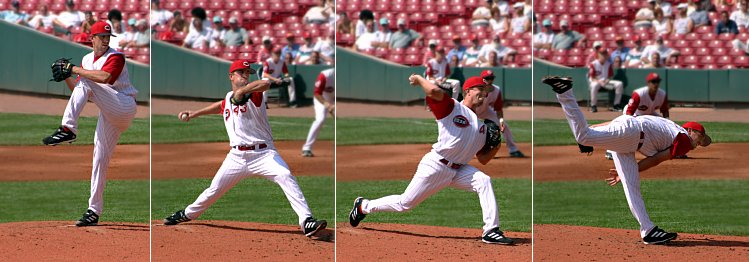Inertia: Difference between revisions
J.williams (talk | contribs) m (1 revision imported) |
No edit summary |
||
| Line 1: | Line 1: | ||
[[Category: Done | [[Category:Done 2018-05-18]] | ||
<onlyinclude>'''Inertia''' is the resistance of any object to changes in its motion or direction.</onlyinclude> There are effectively two types of | <onlyinclude>'''Inertia''' is the resistance of any object due to changes in its motion or direction.</onlyinclude><ref name=Knight>R. D. Knight, "Impulse and momentum" in ''Physics for Scientists and Engineers: A Strategic Approach,'' 3nd ed. San Francisco, U.S.A.: Pearson Addison-Wesley, 2008, ch.9, sec 1, pp. 242.</ref> There are effectively two types of inertia—[[mass]], which is how much of an object exists (often measured in [[units]] like [[kilogram]]s) and rotational inertia. Objects with high mass have more inertia, which means that more [[energy]] is associated with their motion. This takes the form of mass in the [[kinetic energy]] expression: | ||
< | <math>KE = \frac{1}{2}mv^2</math> | ||
More mass means that it takes more energy to get an object moving (which is part of why an SUV uses more [[gasoline]] than a car), and more effort to stop (which is why it takes more [[braking]] to stop a car loaded with several people and luggage than one carrying just the driver). | More mass means that it takes more energy to get an object moving (which is part of why an SUV uses more [[gasoline]] than a car), and more effort to stop (which is why it takes more [[braking]] to stop a car loaded with several people and luggage than one carrying just the driver). | ||
'''Moment of inertia''', also called '''rotational inertia''', < | '''Moment of inertia''', also called '''rotational inertia''', <math>I</math>, is more complicated since it depends both on mass and shape. Rotational inertia (called the moment of inertia by physicists) is an important part of [[rotational kinetic energy]]. The equation for rotational kinetic energy is quite similar: | ||
< | <math>KE_{rot} = \frac{1}{2}I\omega^2</math> | ||
<math>\omega</math> is how fast the object spins around. | |||
[[File:pitching.jpg|800px|center|thumb|Figure 1. Throwing the baseball means the pitcher exerts a force on the ball. The inertia of the ball resists the change in motion.<ref>Wikimedia Commons [Online], Available: https://upload.wikimedia.org/wikipedia/commons/2/25/Baseball_pitching_motion_2004.jpg</ref> Spinning the ball does the same, but it's the rotational inertia that resists motion (the [[torque]] in this case).]] | |||
To learn more about moment of inertia, please see [http://hyperphysics.phy-astr.gsu.edu/hbase/mi.html hyperphysics]. | To learn more about moment of inertia, please see [http://hyperphysics.phy-astr.gsu.edu/hbase/mi.html hyperphysics]. | ||
[[Category:Uploaded]] | |||
== For Further Reading == | |||
For further information please see the related pages below: | |||
*[[Impulse turbine]] | |||
*[[Crossflow turbine]] | |||
*[[Waterwheel]] | |||
*[[Force]] | |||
*[[Momentum]] | |||
*[[Special:Random|A random page]] | |||
==References== | |||
{{reflist}}[[Category:Uploaded]] | |||
Revision as of 21:47, 11 May 2018
Inertia is the resistance of any object due to changes in its motion or direction.[1] There are effectively two types of inertia—mass, which is how much of an object exists (often measured in units like kilograms) and rotational inertia. Objects with high mass have more inertia, which means that more energy is associated with their motion. This takes the form of mass in the kinetic energy expression:
More mass means that it takes more energy to get an object moving (which is part of why an SUV uses more gasoline than a car), and more effort to stop (which is why it takes more braking to stop a car loaded with several people and luggage than one carrying just the driver).
Moment of inertia, also called rotational inertia, , is more complicated since it depends both on mass and shape. Rotational inertia (called the moment of inertia by physicists) is an important part of rotational kinetic energy. The equation for rotational kinetic energy is quite similar:
is how fast the object spins around.
To learn more about moment of inertia, please see hyperphysics.
For Further Reading
For further information please see the related pages below:
References
- ↑ R. D. Knight, "Impulse and momentum" in Physics for Scientists and Engineers: A Strategic Approach, 3nd ed. San Francisco, U.S.A.: Pearson Addison-Wesley, 2008, ch.9, sec 1, pp. 242.
- ↑ Wikimedia Commons [Online], Available: https://upload.wikimedia.org/wikipedia/commons/2/25/Baseball_pitching_motion_2004.jpg


